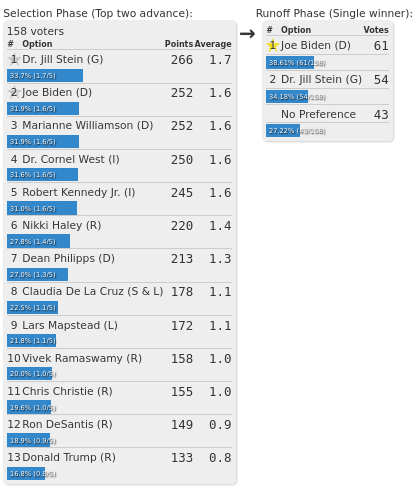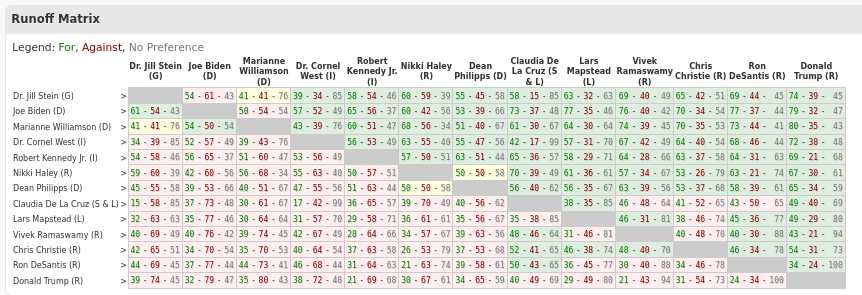What does STAR Voting do when 2nd place is tied?
-


I found a mock election on star.vote , and 2nd place scores were tied between Joe Biden and Marianne Williamson. The website defaulted to Joe Biden, I believe because he was 1st in alphabetical order. Shouldn't 2nd place have gone to Marianne Williamson, since she beats Joe Biden in a runoff?
The election is here https://star.vote/starvotedec23/ . -
@democrates what should happen is that a Condorcet winner should be identified among the frontrunners if one exists. If one doesn’t exist, who knows.
-
@cfrank
 There was no Condorcet winner.
There was no Condorcet winner. 
-
@cfrank I think we have a situation where Joe Biden beats Jill Stein, Jill Stein beats Marianne Williamson, and Marianne Williamson beats Joe Biden. Kind of a rock, paper, scissors scenario. Though, that shouldn't matter in this situation because if Marianne Williamson beats Joe Biden, then she goes to 2nd place and Joe Biden is 3rd, and then Jill Stein wins the election because she is tied with Marianne Williamson in runoff votes, but has a higher score.
-
@democrates I meant a Condorcet winner only among the front runners (for example, the candidates with the top K scores, here we are taking K=2). If there is no Condorcet winner among them, then we can choose the top scoring candidate.
In your case, if two candidates have the same second-greatest score, and the three front runners form a Condorcet cycle, then you can use the scores to break the tie. If this was used, then Jill Stein would have won the election.
That isn’t “the correct” solution (there is no such thing), but it is somewhat less arbitrary than flipping a coin or operating by alphabetical order, neither of which has anything to do with relevant information that is readily available on the ballots.
If we were being engineers about choosing a high quality candidate to win the election, we could even compute the distribution of scores, take the candidates whose scores exceed some elbow point, and find the Condorcet winner among those candidates with the top scoring candidate as the backup if no Condorcet winner exists. That’s basically a generalization of STAR with a dynamic front-runner selection method.
There are other ways to proceed. For example, we could remove Condorcet losers, then try to find the Condorcet winner of all remaining candidates, iteratively eliminating the lowest scoring candidate until a Condorcet winner emerges.
-
@cfrank Yeah, they really need to fix that on the star.vote website. The alphabet is not a good way to determine elections! XD
-
@cfrank said in What does STAR Voting do when 2nd place is tied?:
If we were being engineers about choosing a high quality candidate to win the election, we could even compute the distribution of scores, take the candidates whose scores exceed some elbow point, and find the Condorcet winner among those candidates with the top scoring candidate as the backup if no Condorcet winner exists. That’s basically a generalization of STAR with a dynamic front-runner selection method.
What about a 50% cutoff? That would also dramatically reduce the incentive for turkey-raising—no point in pushing up a bad candidate to help them make the runoff, since now that doesn't eliminate another contender.
-
@lime Yes, a 50% cutoff could work as well. The difficulty is in selecting the non-compensatory criterion to reduce the size of the search space.